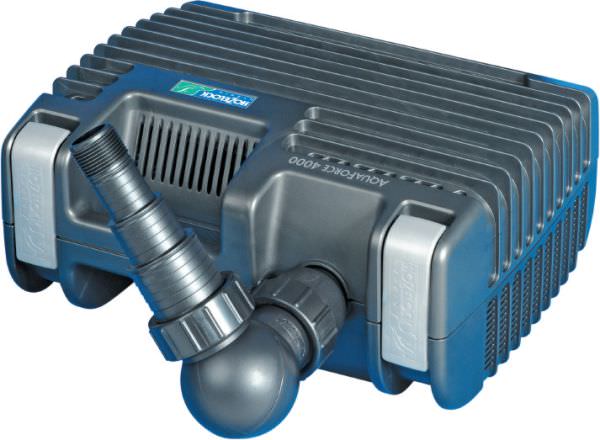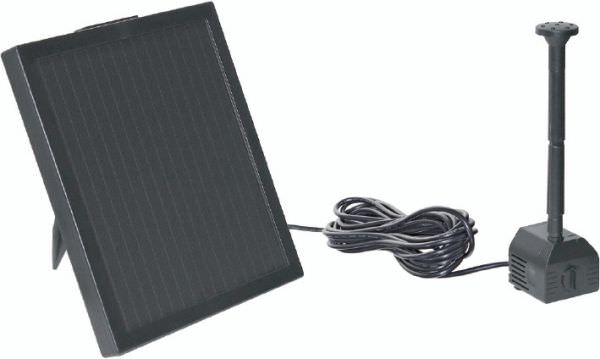
A pump brings your pond to life. The reflections, ripples and sounds of moving water, whether gentle or dramatic, will greatly enhance the beauty of your pond and your enjoyment of it.
More importantly, a pump will assist in maintaining the health of your pond by circulating and aerating the water. Good aeration will mean that oxygen levels in the water will be kept high even during the warmest weather, when fish could otherwise be at risk.
A pump could be described as the heart of the pond, enabling water to be run through ultra violet clarifiers and filters, or to fountains and waterfalls, adding life and health to the whole feature.
Which Pond Pump?
At World of Water you will find pumps of many different types and sizes. We can break them down into five general groups as follows:
Feature Pumps:

A small pump designed to operate features such as pebble pool fountains, ornaments or small self contained features. They really aren’t suitable for use in a garden pond due to the size of prefilter. Most models come with selected fountain attachments as standard.
Fountain/Feature/Waterfall pumps

(Combined General Purpose Pumps): An all round garden pump designed to operate fountains, waterfalls and even filters simultaneously. They usually come complete with various fountain jets and most now have a foamless prefilter for reduced maintenance. This pump is perfect for most small to medium sized garden ponds. These pumps are ideal to be used for fountains because the prefilter protects the small holes in the fountain head from constantly blocking. However the pre filter is still quite fine and does not allow larger solids to pass through to the filter, which is beneficial with koi or in larger ponds.
Filter/Waterfall Pumps

(Solid Handling): Designed to allow larger soft solids to pass through making these pumps perfect for filtration as they deliver waste straight to the filter. Also ideal for waterfalls as they rarely clog and need maintaining. Due to the design of these pumps they are not suitable for running fountains. Many water gardeners will use one of these pumps to operate their waterfall/filtration 24 hours a day and use a general purpose pump to operate a fountain which can be switched off when not required.
Solar Pumps:

As the name suggests these are powered from a solar panel, these pumps are mostly small feature/fountain pumps.
All In One Pumps:

A pond pump with a difference, the pump combines a biological filter and ultra violet clarifier creating a neat integrated unit. Best for smaller ponds where stocking levels are low.
It is very important to consider all your needs before purchasing a pump.
However, there can be no substitute for a chat with one of our in-store experts who will be able to show you all the options available and suggest the correct pump for your individual requirements.
Tips on Selecting a Pond Pump
Always seek advice from an in store expert.
Ensure you have decided on all your requirements before choosing a pump.
Never purchase a pump which is only just powerful enough.
If only running a filter, consider a solid handling pump.
It can be advisable to run a separate fountain pump, to allow you to turn off your fountain without affecting your filter performance.
Tips on Plumbing for Pumps
Always use the recommended hose size for the pump. Most pumps produce volume rather than pressure thus smaller diameter hose or inline restrictions will seriously reduce water flow.
Avoid very long lengths of hose.
Always ensure any stepped hose tails have been cut to the correct size.
Always use clips to secure your hose to fittings.
Try and keep plumbing as simple as possible.
Tips on Positioning the Pond Pump
Position the pump to maximise circulation.
Keep the pump a couple of inches off the pond base with a brick.
Remember you may need regular access to the pump.
If running in the winter bring the pump onto a plant shelf (This helps the fish over winter successfully).
Keep the pump and any heavy water flow or splashing away from lilies.
Tips on Installing Electricity for a Pond Pump
Consult the manufacturer's instructions for installation.
Always use an R.C.D (trip switch). If in doubt consult a qualified electrician.
Ensure cables are suitably protected and buried with warning tape above.
Always use the correct outdoor cable, connectors and switch boxes.
Ensure the correct fuse rating is being used.
World of Water advise that a qualified electrician is consulted prior to installation of electrical equipment in, on or near water or a garden pond Visit www.niceic.org.uk
 British Pounds
British Pounds
